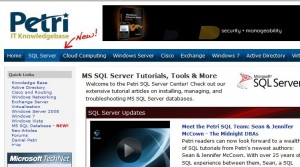 Sean and I have been quietly writing SQL content for the release of the Petri IT Knowledgebase’s new SQL site, which has happened just this week! Not only that, but Petri is publishing a press release tomorrow which will heavily feature us, your MidnightDBAs!! This is really exciting stuff for us, and there’s even more super secret ninja #awesomesauce in the days to come!
Sean and I have been quietly writing SQL content for the release of the Petri IT Knowledgebase’s new SQL site, which has happened just this week! Not only that, but Petri is publishing a press release tomorrow which will heavily feature us, your MidnightDBAs!! This is really exciting stuff for us, and there’s even more super secret ninja #awesomesauce in the days to come!
Hey, as long as we’re blowing our own horn, I should mention the oh-so-VERY-nice blog post that Brad McGehee wrote about Sean’s NTSSUG class. For the last several months, Sean’s been teaching a progressive SSIS class, called Ground Zero SSIS for People who Want to Learn SSIS and Want to Learn to do Other Stuff Good too, before the regular North Texas SQL Server User Group meetings. We talk all the time about how difficult it is to really learn a subject in an hour-long session; this series that Sean’s giving through the year (and posting free on our site!) is meant to counter that limitation.
The North Texas User Group meeting attendance has been growing like gangbusters – our UG president recently attributed our more than 100% growth this year to Sean’s sessions. I’m proud as hell of my hubby, and I’m really delighted that other people are taking note of all that he’s giving back to the SQL community.
So. Um, where was I? Oh yeah, Brad! You should all totally check out Brad’s material on his blog and on Twitter. And, of course, my MidnightDBA blogcast #17 featuring his blog Common Dev/DBA mistakes. 🙂
Okay, enough about us. Hey, I think I’ll finish my blog post about how WE saved SQL Saturday #35! 🙂 In the meantime, here is more US to tide you over.
Happy days,
Jen McCown